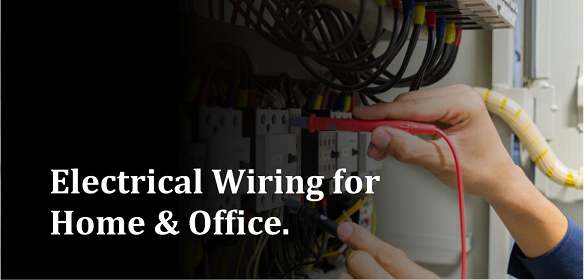- Kapri Complex 3rd Floor, South C Nairobi
- ahmed@eee.co.ke
Efficient Electrical Engineers
Electrical Wiring For Home & Office.
- Home
- Electrical Wiring For Home & Office.

- admin
- No Comments
Electrical wiring is one of the most critical components of any structure, whether it is a house or an office. It provides the necessary electrical power to run lights, appliances, and other electrical devices, and it is critical to a building’s safety and functionality. As a result, it is critical to understand the fundamentals of electrical wiring and to take the necessary precautions to ensure that it is done correctly. This blog will go over electrical wiring for both homes and businesses.
Home Electrical Wiring
Electrical wiring is typically installed in a home through a process known as rough-in, in which electrical boxes and conduit are installed and wires are run through the walls. After the rough-in is finished, the finishing work can begin, which includes installing light fixtures, outlets, and switches.
Non-metallic (NM) cable is the most common type of wiring in a home, and it consists of two or three wires enclosed in a plastic sheathing. Most electrical circuits in a home use NM cable, which is typically run through conduit or channels within the walls.
It is critical to remember that electrical wiring must follow the National Electric Code (NEC) and local building codes. This code establishes guidelines for safe electrical wiring installation and provides minimum standards for the protection of people and property from electrical hazards.
It is best to leave the installation of electrical wiring in a home to the professionals. While incorrect wiring may appear to be a do-it-yourself project, it can lead to serious electrical hazards such as fires, shocks, and electrocutions. Furthermore, most states require a permit for electrical work, and it is critical to have the work inspected by a local building inspector to ensure that it meets code requirements.
Office Electrical Wiring
Electrical wiring in an office is similar to home wiring, with a few additional requirements. Office buildings frequently have higher electrical power demands, and they may also require additional electrical circuits for computer equipment and other specialized devices.
When installing electrical wiring in an office, keep in mind the type of equipment that will be used and ensure that there is enough power to support it. To meet the electrical demand, additional circuits, panels, and transformers may be installed.
Another important factor to consider in an office is the protection of sensitive electronic equipment from power surges, spikes, and other electrical disturbances. Surge protectors and uninterruptible power supplies (UPS) can be used to provide a clean and stable power source for the equipment.
Finally, it is critical to consider the safety of the building’s employees and visitors. Office electrical wiring must comply with the NEC and local building codes, and it is critical to have the work inspected by a local building inspector to ensure compliance.
Conclusion
Electrical wiring is an important component in any building, and it must be done correctly. When installing electrical wiring in a home or office, it’s critical to consider electrical demand, occupant safety, and electrical equipment protection. If you have any concerns about the wiring in your building, get in touch with us.
admin
Recent Comments
No comments to show.
